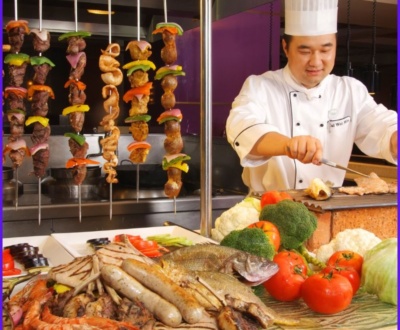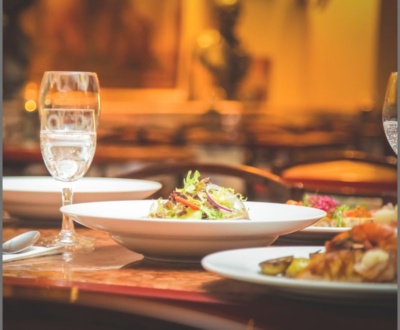Restaurant marketing strategy with 7 Ps (A Comprehensive Guide)
- October 11, 2024
- Uncategorized
Restaurant marketing strategy with 7 Ps: A Comprehensive Guide
Service marketing is an essential part of any business in the hospitality industry, especially for Restaurant marketing strategy with 7 Ps—a concept derived from the traditional 4 Ps (Product, Price, Place, and Promotion)—have been expanded to include People, Process, and Physical Evidence. In the competitive restaurant industry, mastering these 7 Ps can help a business build strong customer relationships, drive growth, and create memorable dining experiences. Let’s explore each element and how it applies to restaurants.
1. Product–
In the restaurant industry, the “Product” is the food and beverage offerings, but it’s more than just what’s on the plate. The product also includes the dining experience, ambiance, and overall customer satisfaction.In service marketing for restaurants, the concept of “product” goes beyond the tangible food items to include a blend of both physical goods and services. In this context, the “product” refers to the total dining experience offered to customers, which includes not only the food but also the service, ambiance, and overall customer experience. Here’s how the product in service marketing for restaurants can be broken down:
- Quality of Food: The quality, flavor, and presentation of dishes are paramount.
- Menu Variety: Offering a diverse menu that caters to different dietary preferences and tastes, from gourmet meals to casual snacks.
- Dining Experience: Service, comfort, and entertainment can also enhance the “product” in a dining context.
2. Price
In restaurant service marketing, price refers to the amount customers pay for food, drinks, and other services. It’s an important part of the marketing strategy because it helps attract customers, covers costs, and influences how people see the restaurant’s value.
- Value for Money: Offering competitive prices without sacrificing quality is key.
- Special Offers: Discounts, promotions, or happy hours can attract price-conscious diners.
- Premium Pricing: For high-end restaurants, premium pricing may be tied to exclusive experiences, ingredients, or gourmet dining.
In short, pricing is about finding a balance between customer satisfaction, covering costs, and making a profit.
3. Place
“Place” refers to the location of your restaurant and how accessible it is to your target audience. It also extends to the distribution channels, including options like delivery and online ordering.
- Location: High foot traffic areas, proximity to office buildings or tourist spots, or trendy neighborhoods can be key to success.
- Online Presence: Optimizing for online ordering or delivery services such as UberEats, DoorDash, or in-house delivery can help reach more customers.
- Convenience: Offering takeout options and parking facilities can enhance accessibility.
4 Promotion-
Promotion in restaurant marketing involves using different strategies to attract customers and increase sales. Here are some simple and effective ways to promote a restaurant:
- Special Discounts or Deals: Offering discounts, like “Buy One Get One Free” or “Happy Hour” deals, encourages people to come in and try the food.
- Social Media Marketing: Use platforms like Instagram, Facebook, or TikTok to post pictures of your dishes, run contests, or share customer reviews to attract more attention.
- Loyalty Programs: Reward customers who frequently visit your restaurant with points, discounts, or free items to keep them coming back.
- Collaborations: Partner with local businesses, influencers, or food delivery apps to reach a larger audience.
- Seasonal Promotions: Offer limited-time menus or deals during holidays or special occasions to create excitement and urgency.
- Events and Live Music: Hosting events like trivia nights, live music, or cooking classes can make your restaurant a destination for people looking for a fun experience.
- Online Reviews and Listings: Make sure your restaurant is listed on Google and review sites like Yelp, and encourage happy customers to leave positive reviews.
These strategies help bring more customers into the restaurant and create a buzz around your business
5. People
In the service industry, your staff is an extension of your brand, and they have a direct impact on the customer experience. Friendly, knowledgeable, and efficient staff can be the difference between a one-time customer and a repeat guest.
- Training: Invest in thorough training for your front-line staff—servers, hosts, and kitchen staff—to ensure top-notch service.
- Employee Engagement: Happy employees are more likely to deliver excellent service, so focus on creating a positive work environment.
- Customer Service: Responsive, professional handling of complaints or special requests plays a significant role in building loyalty.
- and more explore Restaurant marketing strategy with 7 Ps
6 Process-
The “Process” refers to the systems in place to ensure smooth service delivery. This includes everything from how orders are taken to how food is prepared and served.
- Order Efficiency: Streamlined processes for taking orders, both in-house and online, reduce wait times and improve customer satisfaction.
- Kitchen Workflow: A well-organized kitchen with clear communication ensures that food is prepared correctly and delivered to customers promptly.
- Reservation Management: Efficient handling of reservations, waitlists, and seating arrangements is essential for a smooth dining experience.
7. Physical Evidence-
In service marketing, especially within restaurants, physical evidence refers to the tangible aspects that customers can see, touch, and experience, helping to shape their perception of the service provided. Since services are intangible, physical evidence plays a critical role in delivering a positive customer experience and reinforcing the brand’s image. Below are key forms of physical evidence in restaurant service marketing:
1. Ambience and Atmosphere
- Interior Design: The layout, decor, furniture, lighting, and color schemes create the overall look and feel of the restaurant. A fine dining restaurant might have elegant lighting and luxurious furniture, while a casual café may focus on a cozy and relaxed design.
- Music and Sound: The type of music and noise levels contribute to the mood. For example, calm music enhances a serene environment, while upbeat music might be more suitable for a lively, informal setting.
- Temperature and Air Quality: The comfort of the environment, including heating, ventilation, and air conditioning, is part of the sensory experience.
2. Cleanliness and Hygiene
- Dining Area: The cleanliness of tables, chairs, floors, and restrooms is a crucial aspect of the customer’s physical experience and reflects the restaurant’s professionalism.
- Kitchen Visibility: Some restaurants have open kitchens where customers can observe food preparation, providing transparency and confidence in hygiene standards.
3. Staff Appearance and Presentation
- Uniforms: The clothing and appearance of the staff (e.g., chefs, waiters) convey professionalism. Well-dressed staff in clean, branded uniforms make a positive impression.
- Personal Grooming: Well-groomed staff with appropriate attire reflect the restaurant’s commitment to high service standards.
4. Menu Design
- Physical Menus: The design, layout, and presentation of the menu—whether it’s a printed menu or a digital tablet—can enhance the dining experience. High-quality materials and clear, visually appealing layouts give a sense of quality.
- Visuals of Dishes: Professional images of food items help customers visualize the dishes, influencing their choices and creating expectations.
5. Table Settings and Utensils
- Cutlery and Tableware: The quality of plates, cutlery, glasses, and napkins reflect the restaurant’s attention to detail. Premium materials like fine china or high-quality stainless steel convey a sense of sophistication.
- Table Decor: Fresh flowers, candles, or decorative centerpieces create a welcoming and thoughtful atmosphere.
6. Branding and Signage
- External Signage: The restaurant’s exterior signage, logo, and overall appearance play a crucial role in drawing customers in. A well-maintained, stylish exterior communicates brand identity and quality.
- In-House Branding: Logos on menus, napkins, plates, and even waitstaff uniforms reinforce the brand and create a consistent customer experience.
7. Technology and Equipment
- Point-of-Sale Systems: Modern, efficient payment systems or contactless options can create a seamless customer experience, reinforcing convenience and innovation.
- Interactive Touchpoints: In some restaurants, technologies like self-service kiosks, tablets, or mobile ordering systems enhance the customer’s interaction with the service.
8. Food Presentation
- Plating of Dishes: How the food is presented on the plate is a key aspect of physical evidence. Creative, aesthetically pleasing plating elevates the dining experience and influences perceptions of taste and quality.
- Portion Size and Garnishing: The presentation of portion sizes, garnishing, and attention to detail further adds to the overall visual and sensory experience.
9. Restroom Facilities
- Design and Cleanliness: Restrooms reflect a lot about the restaurant’s standards. Clean, well-maintained restrooms with modern fixtures, fresh scents, and necessary supplies indicate attention to guest comfort.
- Aesthetic Touches: Items like quality hand soaps, towels, or scented candles can also enhance the perception of service quality.
10. Takeout Packaging
- Branded Packaging: For customers ordering takeout or delivery, the quality and design of the packaging (e.g., branded bags, eco-friendly containers) act as physical evidence of the restaurant’s attention to detail.
- Durability and Functionality: Packaging that keeps food warm, intact, and presentable by the time it reaches the customer contributes to a positive experience even outside the physical restaurant.
11. Waiting Area and Queuing Experience
- Comfort of Waiting Spaces: Comfortable seating, pleasant surroundings, and even entertainment (e.g., magazines, TVs) in waiting areas contribute to the customer’s perception of service quality during peak hours.
- Queue Management Systems: Digital queue systems that notify customers when their table is ready or mobile apps that let them track their waiting time can reduce frustration and enhance convenience.
12. Special Touches and Extras
- Complimentary Items: Free offerings like bread baskets, after-dinner mints, or drinks create a sense of value and generosity.
- Souvenirs or Branded Items: Some high-end restaurants offer branded items like pens, coasters, or even cookbooks as keepsakes, reinforcing their brand presence long after the meal.
7 P’s of Service Marketing in Restaurant: Understanding and Implementing the Framework
Conclusion
The Restaurant marketing strategy with 7 Ps are essential tools for restaurant owners and managers looking to improve their business and enhance the customer experience. By focusing on Product, Price, Place, Promotion, People, Process, and Physical Evidence, restaurants can create a well-rounded marketing strategy that ensures customer satisfaction and long-term success in a highly competitive market.
Mastering these elements not only attracts new customers but also fosters loyalty, turning one-time diners into regular patrons.

“Unlock the recipe for restaurant success with the 7 Ps of marketing! 🍽️ From perfecting your Product to nailing Promotion, discover strategies to grow your business. #RestaurantMarketing #7Ps #SuccessOnAPlate”
More from our blog
See all postsRecent Posts
- Understanding What is SEO in Digital Marketing : A Comprehensive Guide December 30, 2024
- Benefits of Digital Menu Board(step by step guide for restaurant) October 12, 2024
- Why SEO is important for Restaurant? October 12, 2024







